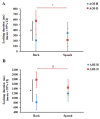Auditory⁻Visual Matching of Conspecifics and Non-Conspecifics by Dogs and Human Infants
- PMID: 30621092
- PMCID: PMC6357027
- DOI: 10.3390/ani9010017
Auditory⁻Visual Matching of Conspecifics and Non-Conspecifics by Dogs and Human Infants
Abstract
We tested whether dogs and 14⁻16-month-old infants are able to integrate intersensory information when presented with conspecific and heterospecific faces and vocalisations. The looking behaviour of dogs and infants was recorded with a non-invasive eye-tracking technique while they were concurrently presented with a dog and a female human portrait accompanied with acoustic stimuli of female human speech and a dog's bark. Dogs showed evidence of both con- and heterospecific intermodal matching, while infants' looking preferences indicated effective auditory⁻visual matching only when presented with the audio and visual stimuli of the non-conspecifics. The results of the present study provided further evidence that domestic dogs and human infants have similar socio-cognitive skills and highlighted the importance of comparative examinations on intermodal perception.
Keywords: cross-modal matching; dog; infant; intermodal cognition.
Conflict of interest statement
The authors declare no conflict of interest.
Figures



Similar articles
-
The influence of infant-directed speech on 12-month-olds' intersensory perception of fluent speech.Infant Behav Dev. 2014 Nov;37(4):644-51. doi: 10.1016/j.infbeh.2014.08.010. Epub 2014 Sep 17. Infant Behav Dev. 2014. PMID: 25238663
-
Watch and listen - A cross-cultural study of audio-visual-matching behavior in 4.5-month-old infants in German and Swedish talking faces.Infant Behav Dev. 2018 Aug;52:121-129. doi: 10.1016/j.infbeh.2018.05.003. Epub 2018 Jul 11. Infant Behav Dev. 2018. PMID: 30007216
-
Cross-modal perception of puppies and adult conspecifics in dogs (Canis familiaris).J Comp Psychol. 2024 Nov;138(4):246-258. doi: 10.1037/com0000385. Epub 2024 Sep 19. J Comp Psychol. 2024. PMID: 39298186
-
The developmental origins of naïve psychology in infancy.Adv Child Dev Behav. 2009;37:55-104. doi: 10.1016/s0065-2407(09)03702-1. Adv Child Dev Behav. 2009. PMID: 19673160 Review.
-
Agility and search and rescue training differently affects pet dogs' behaviour in socio-cognitive tasks.Behav Processes. 2009 Jul;81(3):416-22. doi: 10.1016/j.beproc.2009.03.015. Behav Processes. 2009. PMID: 19520242 Review.
Cited by
-
What Is Written on a Dog's Face? Evaluating the Impact of Facial Phenotypes on Communication between Humans and Canines.Animals (Basel). 2023 Jul 22;13(14):2385. doi: 10.3390/ani13142385. Animals (Basel). 2023. PMID: 37508162 Free PMC article.
-
Differences in dogs' event-related potentials in response to human and dog vocal stimuli; a non-invasive study.R Soc Open Sci. 2022 Apr 6;9(4):211769. doi: 10.1098/rsos.211769. eCollection 2022 Apr. R Soc Open Sci. 2022. PMID: 35401994 Free PMC article.
-
Eye Tracking in Dogs: Achievements and Challenges.Comp Cogn Behav Rev. 2023;18:33-58. doi: 10.3819/CCBR.2023.180005. Comp Cogn Behav Rev. 2023. PMID: 39045221 Free PMC article.
-
Domestic dogs (Canis lupus familiaris) are sensitive to the correlation between pitch and timbre in human speech.Anim Cogn. 2022 Jun;25(3):545-554. doi: 10.1007/s10071-021-01567-4. Epub 2021 Oct 29. Anim Cogn. 2022. PMID: 34714438 Free PMC article.
-
Multimodal Communication in the Human-Cat Relationship: A Pilot Study.Animals (Basel). 2023 May 3;13(9):1528. doi: 10.3390/ani13091528. Animals (Basel). 2023. PMID: 37174564 Free PMC article.
References
Grants and funding
LinkOut - more resources
Full Text Sources

